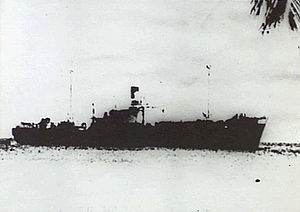German auxiliary cruiser Komet
 |
|
| History | |
|---|---|
|
|
|
| Operator: | Norddeutscher Lloyd |
| Builder: | Deschimag A.G. Weser |
| Launched: | 16 January 1937 |
| Christened: | Ems |
| Homeport: | Bremen |
| Fate: | Requisitioned by Kriegsmarine, 1939 |
|
|
|
| Name: | Komet |
| Namesake: | Comet |
| Operator: | Kriegsmarine |
| Builder: | Howaldtswerke, Hamburg (conversion) |
| Yard number: | 7 |
| Acquired: | 1939 |
| Commissioned: | 2 June 1940 |
| Renamed: | Komet (1940) |
| Reclassified: | Auxiliary cruiser (1940) |
| Nickname(s): |
|
| Fate: | Sunk on 14 October 1942 after hit by a torpedo near Cap de la Hague. |
| General characteristics | |
| Displacement: | 7,500 tons (3,287 GRT) |
| Length: | 115.5 m (379 ft) |
| Beam: | 15.3 m (50 ft) |
| Draught: | 6.5 m (21 ft) |
| Propulsion: | 2 Diesel engines |
| Speed: | 16 knots (30 km/h; 18 mph) |
| Range: | 35,100 nautical miles (65,000 km) |
| Complement: | 274 |
| Armament: |
|
| Aircraft carried: | 2 Arado Ar 196 A-1 |
Komet (German for comet) (HSK-7) was an auxiliary cruiser of Nazi Germany's Kriegsmarine in the Second World War, intended for service as a commerce raider. Known to the Kriegsmarine as Schiff 45, to the Royal Navy she was Raider B.
After completing one successful raid in the South Pacific, she was sunk by British motor torpedo boats in October 1942 whilst attempting to break out into the Atlantic on another.
Launched on 16 January 1937 as the merchant ship Ems at Deschimag A.G. Weser shipyard in Bremen for Norddeutscher Lloyd (NDL), she was requisitioned at the start of the Second World War in 1939, converted into an auxiliary cruiser at Howaldtswerke in Hamburg, and commissioned into the Kriegsmarine on 2 June 1940. The ship was 115.5 m long and 15.3 m wide, had a draught of 6.5 m, and registered 3,287 gross register tons (GRT). She was powered by two diesel engines that gave her a speed of up to 16 knots (30 km/h).
As a commerce raider, Komet was armed with six 15 cm guns, one 7.5 cm gun, one 3.7 cm and four 2 cm AA guns, as well as six torpedo tubes. She also carried a small 15-ton fast boat ("Meteorit", of the "LS2" class) intended to lay mines and an Arado 196 A1 seaplane. Her crew numbered 274.
After a long period of negotiations between Nazi Germany and the Soviet Union, the Soviets agreed to provide Germany with access to the Northern Sea Route through which Germany could access both the Atlantic and Pacific oceans. Although the two countries had signed the Molotov-Ribbentrop Pact (with secret protocols dividing eastern Europe) and an undisclosed German–Soviet Commercial Agreement (1940) (extensive military and civilian aid pact), the Soviet Union still wished to maintain the veneer of being neutral, and secrecy thus was required. Initially, the two countries had agreed to send 26 ships, including four armed merchant cruisers, but because of a variety of difficulties, this was soon reduced to just one vessel, the Komet.
...
Wikipedia
